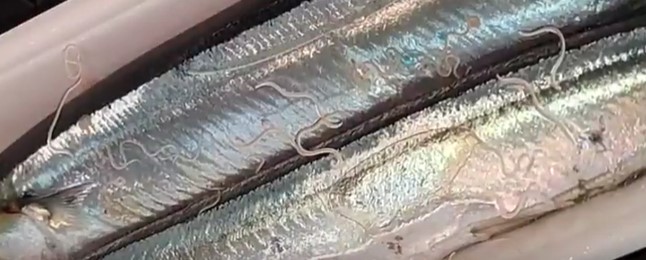
Anisakis is a parasite of fish and shellfish, including mackerel, horse mackerel, sardines, bonito, squid, cod, saury, flatfish, and salmon. Three groups of parasites, Anisakis simplex, Anisakis physeteris, and Pseudoterranova decipiens, are considered to cause Anisakis disease in Japan. Larvae are elongate, 2~3 cm long and 0.5~1 mm wide, and most are translucent white. The species of Anisakis parasitizing fish and shellfish vary depending on the species of fish, the sea area, and the habitat depth.
Anisakis spawns as adults in the stomachs of whales and other marine mammals. When the eggs are excreted with feces, they hatch in seawater, and the larvae are eaten by krill, where they remain as larvae in the krill-eating seafood.
Food poisoning occurs when people eat fish and shellfish parasitized by these larvae. Three to four hours after infection, symptoms such as upper abdominal pain, nausea, and vomiting appear. These symptoms are now known to be an allergic reaction to the stomach wall and the Anisakis, rather than direct pain caused by the Anisakis piercing the stomach wall.
Mackerel is the most common type of Anisakis disease case reported in sashimi and sushi. In Tokyo, more than half of these cases are caused by Shimesaba (vinegared mackerel). When serving ingredients such as sashimi, chefs need to look carefully with their eyes to see if Anisakis is present and to remove the internal organs. Anisakis may not be visible, so care should be taken. The food items should not be served as sashimi if they are visible.
Anisakis larvae are parasites primarily on the surface of internal organs. They do not move from the internal organs if the fish is cold and near iced, but they may move into the flesh as the fish loses freshness or over time. For this reason, removing the internal organs as soon as possible after catch in Japan is considered the most effective preventive measure. This rapid processing is thoroughly implemented as a common practice among markets, wholesalers, and sushi chefs. Additionally, after purchase (or catch), it is crucial to keep the fish chilled with ice or cold packs during transport to prevent Anisakis from moving into the muscle tissue and to maintain freshness.
However, it is important to note that some species of fish, such as Chum salmon (Sake), have Anisakis lurking in their entire body. Sushi chefs know this and do not use it in Nigiri sushi. In addition, it has been hoped that soy sauce, wasabi, and vinegar may be effective in preventing Anisakis disease. However, the insect bodies are not killed by the amount and concentration used in cooking and the time of treatment.
How to Prevent Anisakis
In 1968, the Netherlands mandated by law that herring to be eaten raw in vinegar be frozen at -20 ºC or lower for at least 24 hours before cooking, drastically reducing the number of anisakiasis cases. The U.S. FDA recommends that fish for raw consumption be frozen at -35 °C for 15 hours or at -20 °C for 7 days, while EU health management standards require visual inspection of marine fish for parasites. The EU standard requires visual inspection of marine fish for parasites and directs freezing treatment (at -20 °C or below for at least 24 hours) for marine fish intended for raw consumption. In Japan, heat treatment at 70 °C or higher or 60 °C or higher (for about 1 minute) and freezing at -20 °C or lower for 24 hours or longer are supposed to kill the parasites.
New Technology for Killing Anisakis
Japan Seafoods, a seafood processing company, and Kumamoto University’s Institute for Industrial Nanomaterials Research have jointly developed a method and device to kill Anisakis by using an instantaneous electric power like lightning to kill them in fish meat. The establishment of a new method of killing Anisakis without heating has brought the risk of food poisoning from Anisakis on non-frozen raw sashimi closer to zero. However, challenges remain, such as downsizing the equipment and reducing costs.